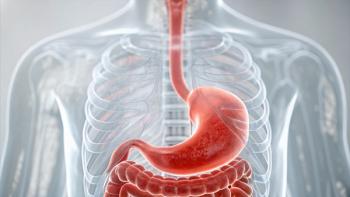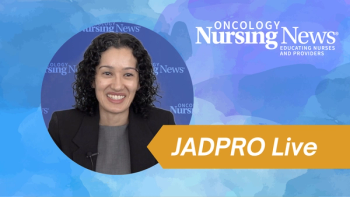
Cannabis Use May Help Decrease Opioid Need in Patients With Cancer
Patients who receive medical cannabis in addition to standard opioids may require less overall opioid treatment to manage their pain.
Medical cannabis in conjunction with opioids may be an effective treatment strategy to reduce pain burden in patients with cancer, according to a presentation at the 47th Annual Oncology Nursing Society Congress.1
Furthermore, health care providers should continue to educate patients and caregivers about the potential benefits and risks associated with medical cannabis, and keep them informed with current available evidence and emerging data to recommend efficacious dosing and formulations.
In doing so, nurses can proactively care for patients experiencing pain burden by identifying which patients might benefit from this treatment based on current conditions, symptomology, and efficacy of previous therapeutics, according to Amber Nenner, BSN, RN; Felita Salim, BSN, RN, OCN; and Ryan Sandler, MS, RN, all of the Columbia University School of Nursing, who presented on the findings in a poster during this year’s meeting.
The authors noted that there is a wide range of symptoms that can affect patients with advanced cancer, including chronic pain, anorexia, chemotherapy-induced nausea and vomiting (CINV), anxiety, and diminished quality of life (QOL). Notably, Dronabinol, a pharmaceutical form of delta-9-tetrahydorcaanobinol and Nabilone, a synthetically made cannabinoid, are FDA approved to treat patients with certain conditions, including CINV.
However, cannabis use continues to remain controversial and best practices surrounding its use remain unclear.
In data presented at the ONS Congress, investigators conducted a literature review to determine the efficacy and safety of medical cannabis as a treatment strategy in oncologic supportive care.
“We felt it was very important to this patient population to seek out research about this treatment option,” Nenner explained in a presentation of the findings. “Specifically, we wanted to discover the current evidence on the effects of cannabis on pain, anorexia, nausea, vomiting, anxiety, and quality of life.”
Study authors searched across Pubmed, CINAHL, and Embase with the following search terms, “cancer AND marijuana,” “oncology AND medical cannabis,” “marijuana AND cancer symptom relief,” “marijuana AND chemo-induced nausea and vomiting,” “medical cannabis AND chemo-induced nausea,” “cancer AND medical cannabis,” and “medical cannabis AND cancer symptom relief.”
Studies were excluded if the participants were under 18 years of age, had preexisting chronic conditions, or non-cancer–related pain.
Prospective Cohort Study
In a prospective cohort study by Anderson et al, investigators enrolled 1120 patients with cancer in a Minnesota MC program.2 These patients were administered a legally purchased 30-day supply of MC that was purchased out of pocket. A total of 743 patients were included in the analysis.
The findings revealed that patient experienced a significant reduction in anxiety, their lack of appetite, depression, disturbed sleep, fatigue, nausea, pain, and vomiting from baseline to 4 months. However, 10.5% of patients also reported drowsiness and dry mouth.
This study was limited by response bias, a lack of control group, limited validated tools, confound variables, and a lack of exclusion criteria.
Systematic Review and Meta-Analysis
The second analysis, by Boland et al, was a systematic review and meta-analysis of randomized controlled studies, which evaluated 6 studies in its review and 5 studies in the meta-analysis.3 Patients had chronic cancer pain and were on regular opioids. These patients received cannabinoids via any route vs placebo or other analgesia.
Overall, there was no mean difference in pain between cannabinoids vs placebo and adding cannabinoids to opioids was not found to augment pain reduction. There was also a higher risk of adverse events (AEs) in the cannabinoids arm vs the placebo arm: patients receiving cannabinoids experienced somnolence and dizziness.
This study was limited by pain scale use, high attrition rate, and confound variables.
Double-Blind Phase 2/3 Trial
In an Australian, randomized, double-blind, placebo-controlled phase 2/3 trial by Grimison et al, investigators assessed 81 participants with refractory CINV, despite antiemetic prophylaxis during emetogenic intravenous chemotherapy.4 Cycle A involved 1 to 4 self-titrated oral THC:CBD 3 times daily for days 1 to 5, while cycle B involved matching placebo crossover design. Cycle C assessed blinded patient preference.
Compared with placebo, THC:CBD was associated with significantly decreased nausea, vomiting, use of rescue medications, and improved QOL in physical and mental health.
However, 31% of patents reported AEs with THC:CBD vs 7% of patients on placebo. Overall, 83% of patients preferred TBH:CBD and 15% of preferred placebo.
Limitations for this study included the crossover design, as well its possible non-representative sample, and confound variables.
Retrospective Chart Review
A retrospective chart review, by Pawasarat at el, evaluated 232 patients enrolled in the State of New Jersey Medicinal Marijuana program, 137 of whom received medical marijuana and 95 of whom did not.5 Electronic health records were reviewed to identify instances of pain, tiredness, appetite, drowsiness, depression, anxiety, and shortness of breath.
Findings concluded that there were no significant differences between the 2 arms; however, the arm without marijuana required 63% more daily opioids to manage their pain.Investigators determined that conjunction marijuana use can delay the need and intensity of opioids treatment.
Study limitations included confound variables and limited application to solid malignancies.
Randomized Phase 2 Trial
In a double-blind, randomized, phase 2 trial, by Schloss et al, enrolled 88 patients with high-grade glioma to assess the tolerability of oral THC:CBD plus standard treatment for 12 weeks.6 Patients were randomized 1:1 to receive THC:CBD/standard treatment or a 4:1 ratio of THC:CBD.
Data revealed that a nightly dose of THC MC (preferably 1:1) was safe, linked to no serious AEs, and significantly improved sleep quality, functional well-being, and QOL.
Limitations included the lack of placebo, high attrition rate, cohort heterogeneity, short follow-up, and possible outcome bias.
Pilot Retrospective Chart Review
A pilot retrospective chart review by Zylla et al used a state-sponsored MC program that assessed 30 patients, 15 of whom received standard cannabis treatment and 15 of whom received delayed cannabis treatment.7 Participants were queried on scales of pain, side effects, and overall satisfaction.
Overall, patients who received earlier cannabis treatment reported improved pain levels and a 20% reduction in opioid usage. In contrast, the patients who received delayed cannabis needed a 57% increase in opioid use for pain management.
Limitations for this study included a small sample size, no placebo or binding, response bias, high attrition rate, and a limited analysis.
Will Medical Cannabis Replace Opioid Use?
The cumulative evidence does not suggest that medical cannabis will replace standard opioid therapy, the authors concluded. However, it was found to be an effective adjunct among those who were opioid refractory, and helped to reduce the overall need for opioid consumption by reducing pain intensity.
In addition, THC:CBD formulations improved the conditions of patients with CINV, and THC:CBD tablets increased the weight and appetites of patients with anorexia and cachexia. The wide range of cannabinoid receptors on the body ultimately responded to the drugs and resulted in improved QOL by improving sleep, depression, and anxiety.
Common AEs associated with cannabis included CNS, dizziness, somnolence, disorientation, gastrointestinal disturbances, hallucinations, and altered functional status.
Finally, the authors noted that most studies had no uniform dosing strategy and presented a variety of routes, cannabis products, doses, and high attrition rates.
“Results from these [studies] are anecdotal at best; further, high-quality studies are needed to create standardized guidelines for clinical application,” Nenner summarized.
“It is important to identify which patients may benefit from medical marijuana as it may alleviate symptom burden in conjunction with standard therapies. However, nurses must assess the current legal guidelines in their states and educate patients and caregivers of its benefits and risks to facilitate shared decision-making,” Salim added.
References
- Nenner A, Salim F, Sandler R, et al. Cannabis and symptom management in cancer, efficacy, and implications for clinical use. Presented at: 47th Annual Oncology Nursing Society Congress; April 27-May 1, 2022; Anaheim, CA. Abstract P4.
- Anderson SP, Zylla DM, McGriff DM, Ameson TK. Impact of medical cannabis on patient-reported syndromes for patients with cancer enrolled in Minnesota’s Medical Cannabis Program. J Clin Oncol. 2019;15(4).e338-e345. doi:10.1200/JOP.18.00562.
- Boland EG, Bennett MI, Allgar V, Boland JW. Cannabinoids for adult cancer-related pain: systematic review and meta-analysis. BMJ Supportive & Palliative Care. 10(1),14-24. https://spcare.bmj.com/content/10/1/14
- Grimison P, Mersiades A, Kirby A, et al. Oral THC:CBD cannabis extract for refractory chemotherapy chemotherapy-induced nausea and vomiting: a randomized, placebo-controlled, phase II crossover trial. Ann Oncol. 2020;31(11):1553-1560. doi:10.1016/j.annonc.2020.07.020.
- Pawasarat IM, Schultz EM, Frisby JC, et al. The efficacy of medical marijuana in the treatment of cancer-related pain. J of Palliative Medicine. 2020;23(6):809-816. doi:10.1089/jpm.2019.0374
- Schloss J, Lacey J, Sinclair J. A phase 2 randomized clinical trial assessing the tolerability of two different ratios of medical cannabis in patients with high grade gliomas. Front Oncol. 2021;11:649555. doi:10.3389/fonc.2021.649555.
- Zylla DM, Eldund J, Gilmore. A randomized trial of medical cannabis in patients with stage IV cancers to assess feasibility, dose requirements, impact on pain and opioid use, safety, and overall patient satisfaction. Support Care Cancer. 2021;29(12):7471-7478. doi:10.1200/JCO.2019.37.31_suppl.109.


















































































